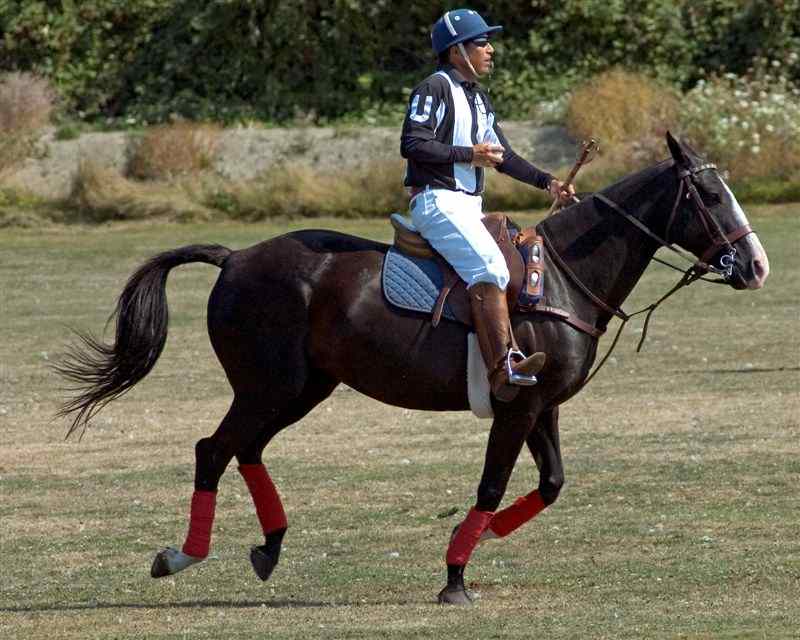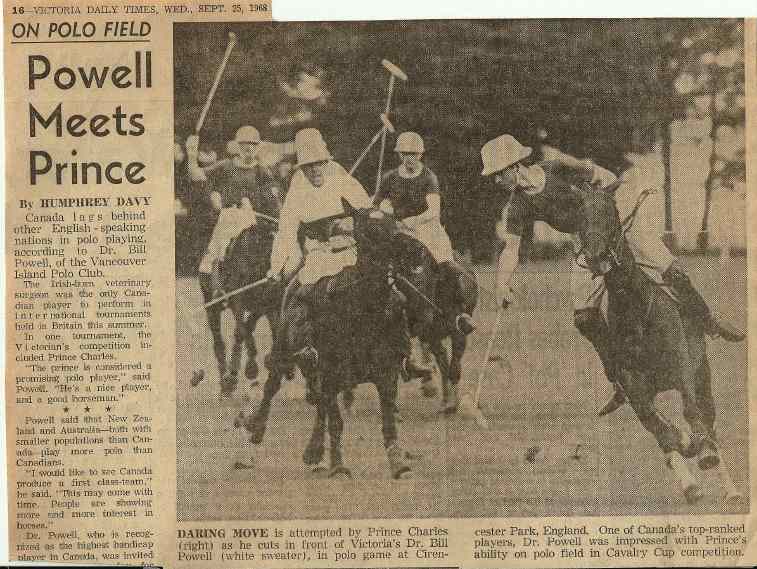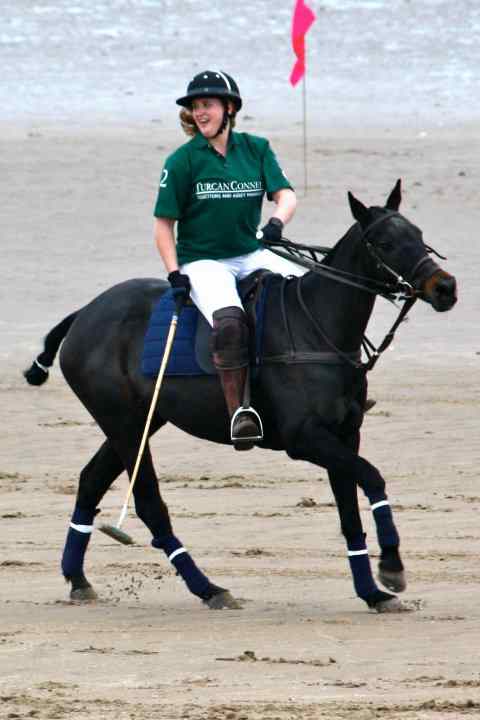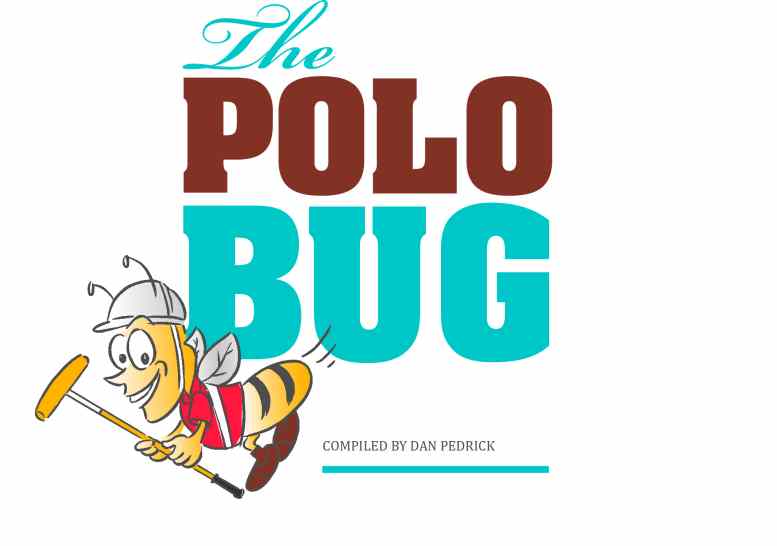The Polo Bug: How I Got It
Susan Kent Stovall

I cannot remember not being around polo. The bug had me and my whole family before I was born, I guess, and I grew up with it.
My father had a cattle ranch in the Yakima Valley located within the Yakima Indian Reservation. He ran mother cows on his land as well as on the reservation during the summer months. We were all riders. My grandmother, Ruth Parton, was the first licensed woman horse race trainer in California and back in the thirties had as many as twenty plus head at Santa Anita racetrack. She was World Champion relay rider in 1912 - 1916 , traveling by train with her Canadian bred thoroughbred horses all over the West. She is in the National Cowgirl Museum and Hall of Fame.
Dad decided to play polo when he was at a movie theatre one time and saw a newsreel that showed polo. Does anyone remember newsreels? Anyway, Dad decided he thought he would like to try the sport and the bug took hold, but good. Soon polo weekends were part of our lives. Sometimes there would be a thousand people watching the games in the Yakima Valley. It was what you did on a Sunday aftenoon. Spectators and the sports reporters knew the horses by name and everything was written up in the local papers.
Dad played all over the Northwest with his family as well as in Santa Barbara in the winter months back in the fifties and early sixties when Santa Barbara was still a winter club. Dad's last game was in 1992 when he turned 80 (born in 1912) with his whole family playing.
As you can see, I'm still at it....
(Susan Kent Stovall is Director of Polo at Costa Careyes Polo Club in Mexico. The Harry Kent Memorial Cup was held at the Spokane Polo Club last September.)
Nigel Yonge

I suppose you could say I got the polo bug by way of family genes. My two times Great Uncle Ned, a Welsh Fusilier, was determined to be a very good player or die trying. Sadly, he did just that after being t-boned during a match in India in 1906.
My mother's father, Basil (Nip) Parker, also played, but not before he returned from World War II minus a leg. Not to be deterred by the mere inconvenience of having just one lower limb, he played with a wooden one stuffed into a boot that was tied to his stirrup leather. Once, when he came off, his prosthetic leg and boot remained attached to the fleeing horse, much to the shock of onlookers!
And then there's my father, Tony Yonge. If I have the bug, it is he who has a full blown infestation. He first got it when he watched some matches in England in the 1950s. The bug fully took hold a bit later when he emigrated to Canada and ultimately met my mother's family - all of whom rode or played polo at Southlands Riding and Polo Club in Vancouver. He later helped start the Victoria Polo Club on Vancouver Island where I was raised. When I was about 5, he made me a lightweight mallet and began coaching me atop my first polo pony, a Welsh pony with the warrior name of "Mrs. Tiggywinkle". I stick and balled in my mother's jumping field and with my father and grandfather between chukkers at the club.
The bug didn't truly manifest itself in me until the mid 1970s when my father got me into a real game at the Delta Polo Club near Vancouver. The pace was fast and by the time I was about ten I could keep up with my dad and uncle Jonty who also played.
Polo wasn't just a pastime on our farm, but a religion. Fittingly, it was on Sundays in the summer months when whites were donned for competitive club matches at Dr. Bill Powell's field, and later at the current Victoria Polo Club started by Steve Mann. This went on from my teen years and into my twenties when I would come and visit on weekends.
A couple of years ago, I was on the field when my dad played his last
game at age 80. Now, pretty much a city slicker, I don't play near as
much as I used to, but it's safe to say I still have the bug. Whenever
our family takes a trip to the country, I point out to my bemused wife
and kids all the flat chunks of land that would make good polo fields!
Robert Lyn-Kee Chow

I was introduced to polo when my parents took the family to matches at the St. Elizabeth Polo Club in Jamaica. My Uncle, Ray Godfrey (actually a family friend), took me for a ride down the field after a game. Soon I was venturing off on my bike to Uncle Ray's, and Uncle Mike's polo barn to chat with their groom and pet the horses.
At age fifteen I was given a chance to play when Stanford Chin offered to loan me a horse if I paid for the grain, and I learned something about polo and the value of a dollar. That's when I actually got the polo bug. I won my first tournament the very next spring. Then I was really hooked!
When I was sixteen, we moved to Canada which seemed very far from polo until I met Tony Yonge. He was very encouraging and got me a job at the Vancouver Polo Club where I met Ryan Reddell and Harley Stimmel from Midland, Texas.
I managed to graduate early from high school and went back to Jamaica just in time for the winter season. I had the bug bad and was determined to play. Uncle Mike generously loaned me his horses and hauled them from Mandeville to Drax Hall Polo Club. I had no place to stay so I slept in the men's room at the club, living on sardines and hard dough bread--but that didn't bother me, I was playing polo! Then Danny Melville took pity on me and moved me to his beach house in Ocho Rios. Talk about moving uptown!
I returned to Canada with some experience but still looking for more. For three summers I worked for the Dix family in Spokane where the best polo in the Pacific Northwest was then found. After graduating from Florida Atlantic University in Boca Raton, I wanted to go where the polo was good and I could play a lot. Eddie Moore invited me to his place in Argentina, and I considered it. But, when Ryan Reddell invited me to Midland, Texas, off I went.
The Midland Polo Club was generously supported by Carlton Beal and it could field a 26 goal team with club members! There was Bart and Robert Evans, Hector Galindo, Miguel Torres, Steve Dalton, to name just a few. We played polo six days a week, year round, weather permitting. One time we played for thirteen days straight. I was relieved when we finally took a day off so I could do my laundry! I was soon managing the club and doing the books. I went to three goals there and had a lot of fun doing it.
I visited Midland last spring. The club seemed hardly any different
and it was good to see old friends after such a long time. The polo
bug is still with me. Good fields, good friends and good horses make
it all worthwhile!
Barbara Powell, D.V.M.

We were two young Irish veterinarians, recently arrived in Vancouver and living in an equestrian area close to a riding club. We had ridden most of our lives and Billy had been a successful show jumper. But, we had decided that the sea had more allure than riding just then so we bought a sailboat to explore the West Coast and Gulf Islands.
Then we met two young New Zealanders managing a boarding stable nearby and looking for riders for a broomstick polo game on an adjacent field. They imparted their enthusiasm to Bill and he bought a horse, a beautiful half Arab mare, who unfortunately preferred rearing to getting anywhere near a polo ball. Undaunted, he then purchased a lovely small thoroughbred for $100 which turned out to be a "natural.
Several pre-war polo players donated some ancient mallets with Malacca canes and cigar shaped heads, so the broomsticks were not needed. The field was a rough pasture and a large ball was used to play an indoor-outdoor three-a-side game. Although primitive, everyone had fun.
Later that year we went on holiday, driving to California with Mexico as a destination. On our third night we stopped in Santa Barbara. At the motel reception desk a magazine showing local events was provided. There was a polo player on the cover (Bob Skene) and details inside of a club in nearby Carpinteria.
The manager introduced us to the players who were most welcoming. Billy was offered a horse to take lessons from the coach, retired 8 goal player Harry East. We spent the remaining holiday taking lessons daily. Dean Mullins, the horse manager of the nearby Jackson Ranch, where polo ponies were bred and trained, was a wonderful horseman and invited us to come and ride in the mornings when he taught us so much about riding and schooling polo ponies. It was marvelous and we were hooked!
Next year we took our pony Cherokee with us and bought a pony from the Jackson Ranch (as Billy said, he had doubled his string! ), spending our holiday in polo and horsemanship instruction once again. This served Billy so well throughout his long polo career, being known for his good form, stick work and accurate hitting.
Billy became an addict, playing each winter in California. We bought land and started a polo club near our home in Victoria, B.C., recruiting local players while hosting teams from all over the Pacific Northwest in summer. Highlights of our polo adventures included traveling with a sixteen-goal team to New Zealand and Australia, and with a team to play in the Gold Cup of India. Billy played in Argentina and Barbados, and we spent a wonderful five weeks playing in Hawaii hosted by Fred Dailey in his Waikikian Hotel, and at Mokuleia. Some summers we spent in England playing at Cirencester, Windsor, and Rutland, where one of the 'high goalers' Billy played against was Cody Forsythe, son of one of the young men who had got us started in Vancouver.
We met and played with many wonderful characters over the years including (on the notable side) HRH Prince Charles, the Maharaja of Jaipur, Ronnie and Susan Ferguson, Sir 'Cow' Williams, and many, many others.
Bill played until his late seventies. I still have "Nugget," our last pony, so I
guess I have still got The Polo Bug.
Adam Crocker Snow

I think the Polo Bug began circling when I got home from Japan my 5th grade year and watched my older cousin, Doo Little, gallop around Bird's Field in Ipswich on a big chestnut hitting all the shots. He made it look so easy. There was a wooden horse in the barn at Bird's Field, which was a very useful learning tool. That summer, when I watched Doo team-up with Gene and Paul Fortugno to represent a “young Myopia” team on the Sunday field, it looked like they were flying – shirt-tails flapping, at one with their horses – I wanted to be out there, but the horses still presented an obstacle.
My grandfather, Crocker Snow, started me stick-and-balling on a small field at his place. If I missed the ball he would make me circle, keep the horse on the same lead, and then try to hit it again while keeping my horse steady. My brother Andrew and I played together endlessly on that little hayfield. When we wanted a bigger field than our grandfather's we would ford the Ipswich River on horseback and go stick-and-ball at Bird's Field.
My grandfather's field had a boulder sticking part-way out of the ground in the middle of it. That rock had a lot of character. Years later, playing in a big game, I'd picture that stone on the field I learned to play on. I visit there from time to time, and I touch it still. It is kind of a centering symbol for me.
A clinic with Mike Andrews in the Myopia arena gave me some equestrian fundamentals -- I still tie my tails and wrap my bandages the way he taught me -- but I was the only youngster in the clinic and the horses still seemed huge and unpredictable. Out of the first throw-in in my first practice game I hit the ball three times in a row. I got so surprised and excited I fell off. I was scared but I got back on. The horse, Scooter, threw me off again. The third time I really got bucked off. For over a year I didn’t even want to look at a horse!
Then, the summer before my eighth grade year, a kids’ clinic was organized at Myopia and the Polo Bug bit me for real. Twelve kids, all within a few years of each other, took lessons from my father and Tommy Monnaco. Soon we were playing two chukka round-robins during half-time of the 3pm Sunday matches. In this venue with peers, my competitive instincts finally overrode any concerns about riding big horses. Before I knew it I had forgotten about my horse issues in pursuit of hitting that little white thing and trying to put it through the uprights.
As a thirteen year old, the horse was a necessary means to get where I wanted to go in order to hit the ball. Today that same horse (improving them, maximizing their potential) is the single most compelling aspect of the sport for me. It’s the added dimension that makes polo special compared with all the other sports (ice-hockey, lacrosse and now soccer) that I also love.
Danielle Ward

My first experience with polo saw me in the backseat of my parents’ jeep at the age of ten, pulling into the local polo club on a whim. A love of horses ensured that I paid some attention to the game and I left with the opinion that it looked pretty cool, which was a high endorsement indeed. I also left that day with a “grooming” job arranged for the upcoming club tournament, secured without prompting by my father who has always been active in furthering my involvement in any activity he deemed appropriate. He’s never been broken of this presumptuous and occasionally endearing habit because he is, thankfully, often correct in his assumptions and I am rarely given the grounds upon which to scold him.
Polo ultimately became a family pursuit, which is fortunate given that rather than simply improving my riding as my father assumed the experience would do, it had every opportunity to backfire when the tournament proved to be my first exposure to the incurable disease, the ‘Polo Bug’, which has monopolised so much of our collective time and energy (amongst other resources) since then.
My fate was sealed by the next summer, during which I worked as a groom for a self- proclaimed “nasty old geezer” (otherwise known as the extremely kind and pedagogic editor of this feature), who, along with other club members, provided me with the horses and tutelage that would carry me in my first attempts at stick-and-balling and my introduction to what I believe to be the most fun to be had on horseback. Although I eventually began spending more time on the pitch than the pony lines, I am so grateful for the grounding that I received by entering the sport from the ground up, so to speak, and to this day credit my exceptional mudknot to that early instruction.
Polo carried me through my early adolescence as an eager groom into teenaged summers as a very green player during which friends didn’t understand why I spent more time with my ponies than I did with them. Even more dramatically, it gave me the opportunity to grow from being the youngest player at the Victoria Polo Club on the west coast of Canada to becoming the captain of the University of St. Andrews Polo Club on the east coast of Scotland where I am so very lucky to be able to continue to chase that little white ball during the winter months, which lures all of us on to the pitch. While I can’t be certain this state of year-round play will always be my reality, I will always treasure the people, the experiences and the pursuit that polo has provided me which will keep me forever tied to what I’m sure are the best days of my life.
So, Who's Next...?

Try to keep it under five hundred words, please. A decent photo would be great, too. Thanks!
